Leadership Project: Strategic Leadership at Tesco, Ireland
VerifiedAdded on 2022/08/20
|17
|4735
|14
Project
AI Summary
This project delves into strategic leadership and sustainability within Tesco, Ireland, addressing the challenges and opportunities associated with change management. The project begins with an executive summary and introduction, outlining the research's purpose and context within the theory of the strategic role of a leader. It then provides a detailed description of Tesco, including its history, industry, and organizational structure, and focuses on the sustainability management project. A leadership analysis is conducted, examining the roles and responsibilities of leaders in driving change and promoting sustainability. The project outlines the nature of the sustainability project, including its costs, processes, resources, and desired outcomes, along with an evaluation plan. The core of the project emphasizes the importance of strategic leadership in navigating internal and external drivers of change, such as technological advancements, economic factors, and competitive pressures, and the role of leadership in fostering collaboration and aligning the workforce with organizational goals. The project highlights how strategic leadership can influence decision-making, enhance organizational prospects, and ensure long-term success, particularly in the context of sustainability initiatives. The project aims to provide insights into how Tesco, as a major player in the retail market, can effectively manage change, drive innovation, and promote the well-being of its customers and community through sustainable practices.
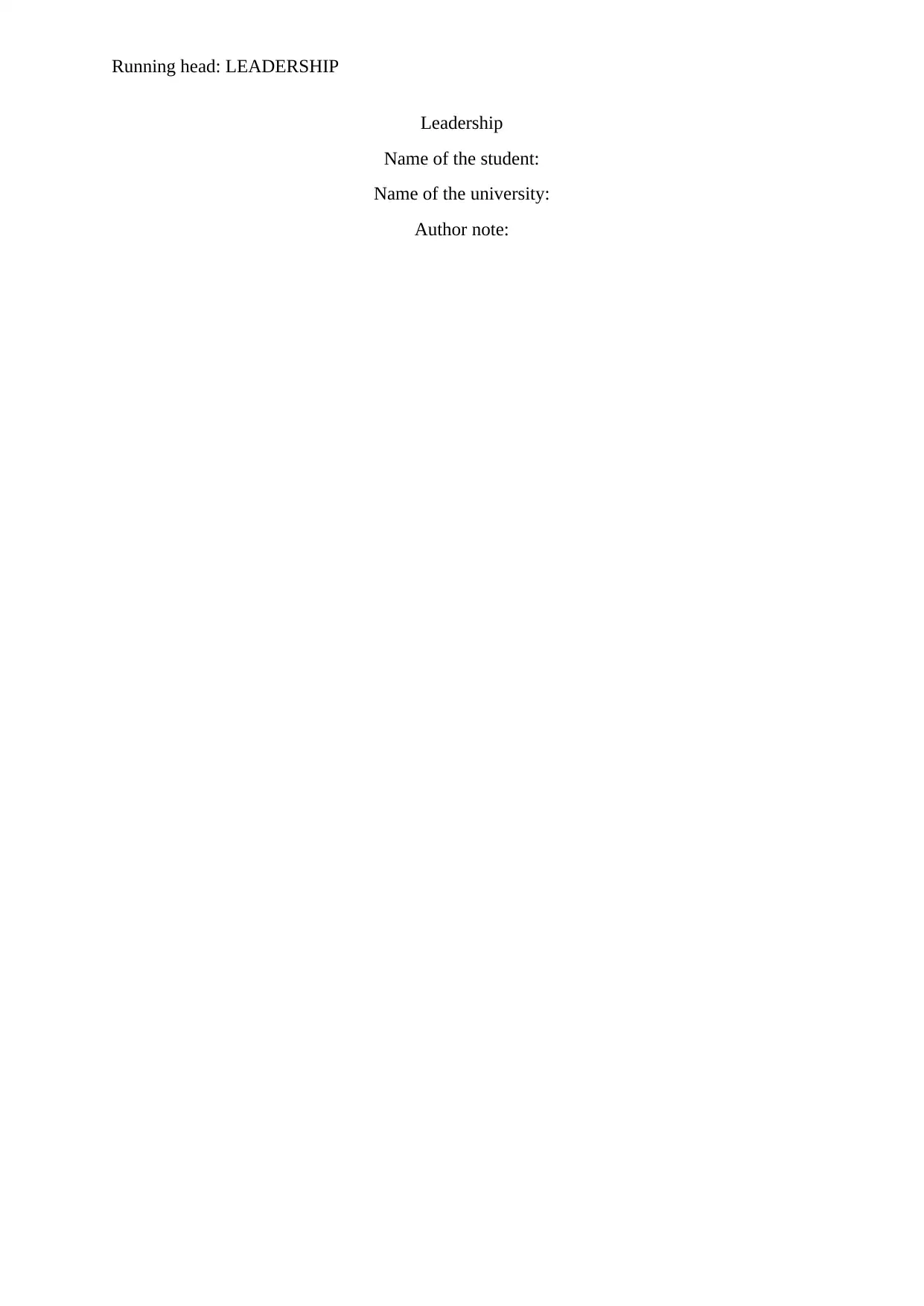
Running head: LEADERSHIP
Leadership
Name of the student:
Name of the university:
Author note:
Leadership
Name of the student:
Name of the university:
Author note:
Paraphrase This Document
Need a fresh take? Get an instant paraphrase of this document with our AI Paraphraser
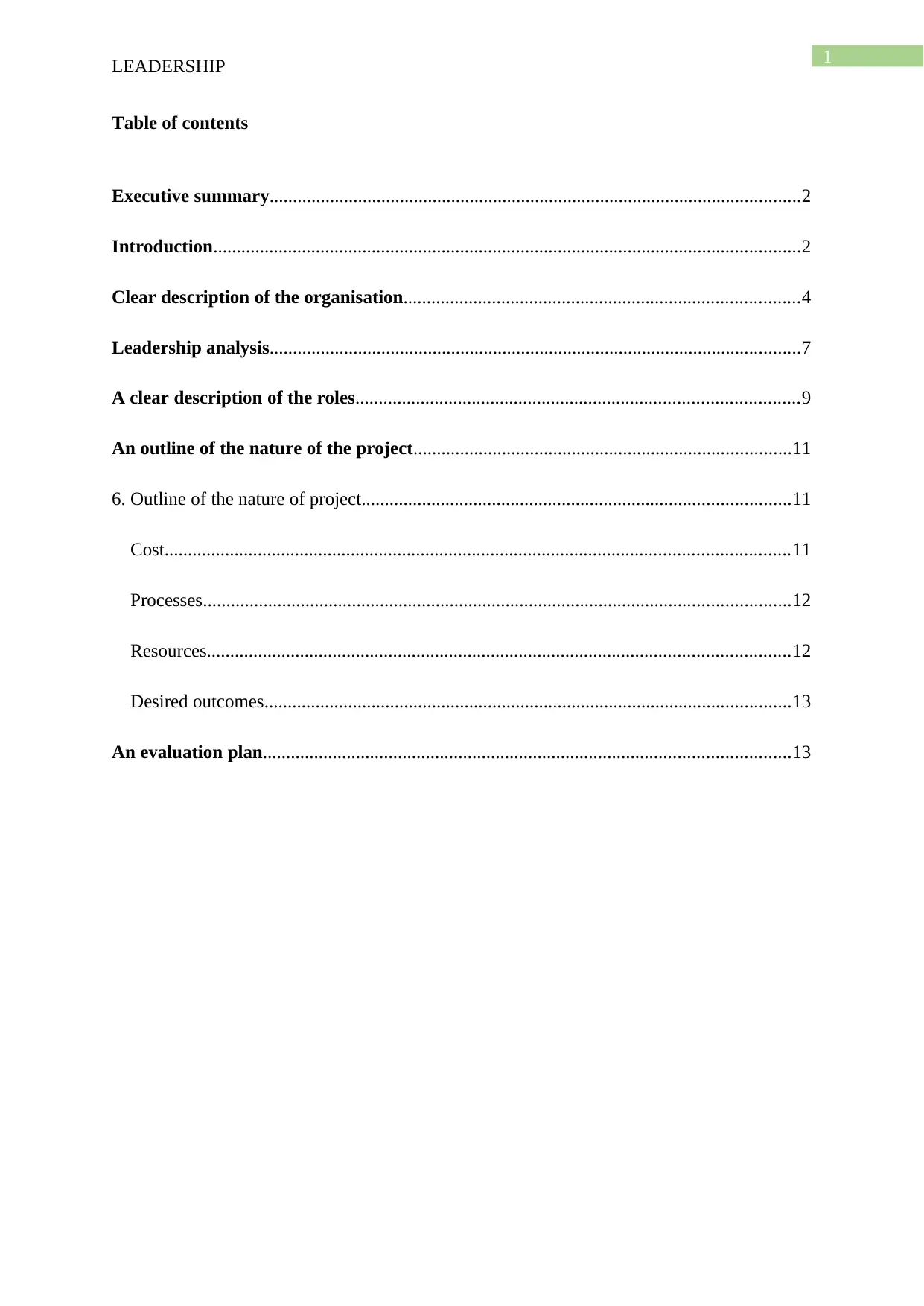
1
LEADERSHIP
Table of contents
Executive summary..................................................................................................................2
Introduction..............................................................................................................................2
Clear description of the organisation.....................................................................................4
Leadership analysis..................................................................................................................7
A clear description of the roles...............................................................................................9
An outline of the nature of the project.................................................................................11
6. Outline of the nature of project............................................................................................11
Cost......................................................................................................................................11
Processes..............................................................................................................................12
Resources.............................................................................................................................12
Desired outcomes.................................................................................................................13
An evaluation plan.................................................................................................................13
LEADERSHIP
Table of contents
Executive summary..................................................................................................................2
Introduction..............................................................................................................................2
Clear description of the organisation.....................................................................................4
Leadership analysis..................................................................................................................7
A clear description of the roles...............................................................................................9
An outline of the nature of the project.................................................................................11
6. Outline of the nature of project............................................................................................11
Cost......................................................................................................................................11
Processes..............................................................................................................................12
Resources.............................................................................................................................12
Desired outcomes.................................................................................................................13
An evaluation plan.................................................................................................................13
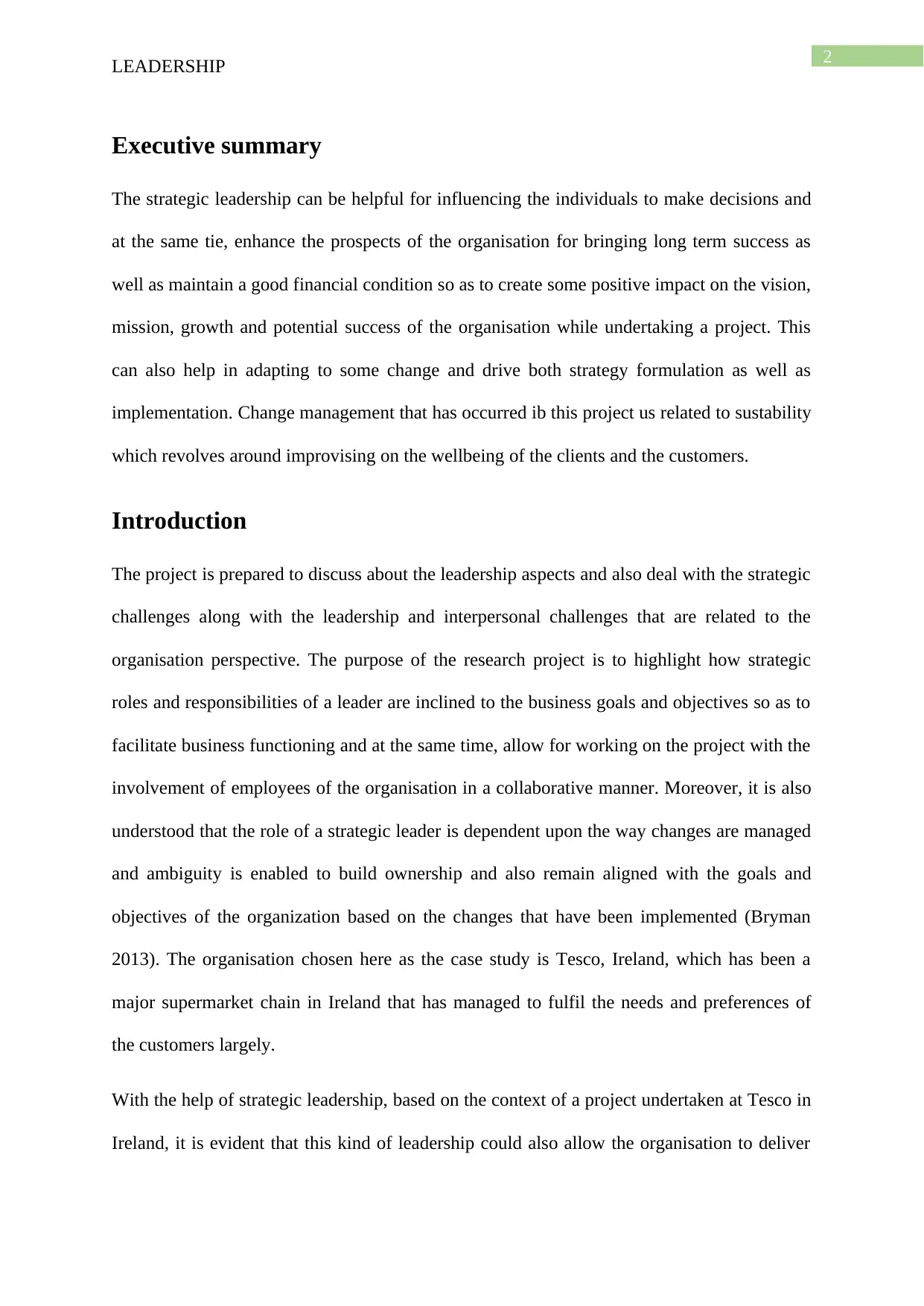
2
LEADERSHIP
Executive summary
The strategic leadership can be helpful for influencing the individuals to make decisions and
at the same tie, enhance the prospects of the organisation for bringing long term success as
well as maintain a good financial condition so as to create some positive impact on the vision,
mission, growth and potential success of the organisation while undertaking a project. This
can also help in adapting to some change and drive both strategy formulation as well as
implementation. Change management that has occurred ib this project us related to sustability
which revolves around improvising on the wellbeing of the clients and the customers.
Introduction
The project is prepared to discuss about the leadership aspects and also deal with the strategic
challenges along with the leadership and interpersonal challenges that are related to the
organisation perspective. The purpose of the research project is to highlight how strategic
roles and responsibilities of a leader are inclined to the business goals and objectives so as to
facilitate business functioning and at the same time, allow for working on the project with the
involvement of employees of the organisation in a collaborative manner. Moreover, it is also
understood that the role of a strategic leader is dependent upon the way changes are managed
and ambiguity is enabled to build ownership and also remain aligned with the goals and
objectives of the organization based on the changes that have been implemented (Bryman
2013). The organisation chosen here as the case study is Tesco, Ireland, which has been a
major supermarket chain in Ireland that has managed to fulfil the needs and preferences of
the customers largely.
With the help of strategic leadership, based on the context of a project undertaken at Tesco in
Ireland, it is evident that this kind of leadership could also allow the organisation to deliver
LEADERSHIP
Executive summary
The strategic leadership can be helpful for influencing the individuals to make decisions and
at the same tie, enhance the prospects of the organisation for bringing long term success as
well as maintain a good financial condition so as to create some positive impact on the vision,
mission, growth and potential success of the organisation while undertaking a project. This
can also help in adapting to some change and drive both strategy formulation as well as
implementation. Change management that has occurred ib this project us related to sustability
which revolves around improvising on the wellbeing of the clients and the customers.
Introduction
The project is prepared to discuss about the leadership aspects and also deal with the strategic
challenges along with the leadership and interpersonal challenges that are related to the
organisation perspective. The purpose of the research project is to highlight how strategic
roles and responsibilities of a leader are inclined to the business goals and objectives so as to
facilitate business functioning and at the same time, allow for working on the project with the
involvement of employees of the organisation in a collaborative manner. Moreover, it is also
understood that the role of a strategic leader is dependent upon the way changes are managed
and ambiguity is enabled to build ownership and also remain aligned with the goals and
objectives of the organization based on the changes that have been implemented (Bryman
2013). The organisation chosen here as the case study is Tesco, Ireland, which has been a
major supermarket chain in Ireland that has managed to fulfil the needs and preferences of
the customers largely.
With the help of strategic leadership, based on the context of a project undertaken at Tesco in
Ireland, it is evident that this kind of leadership could also allow the organisation to deliver
⊘ This is a preview!⊘
Do you want full access?
Subscribe today to unlock all pages.

Trusted by 1+ million students worldwide
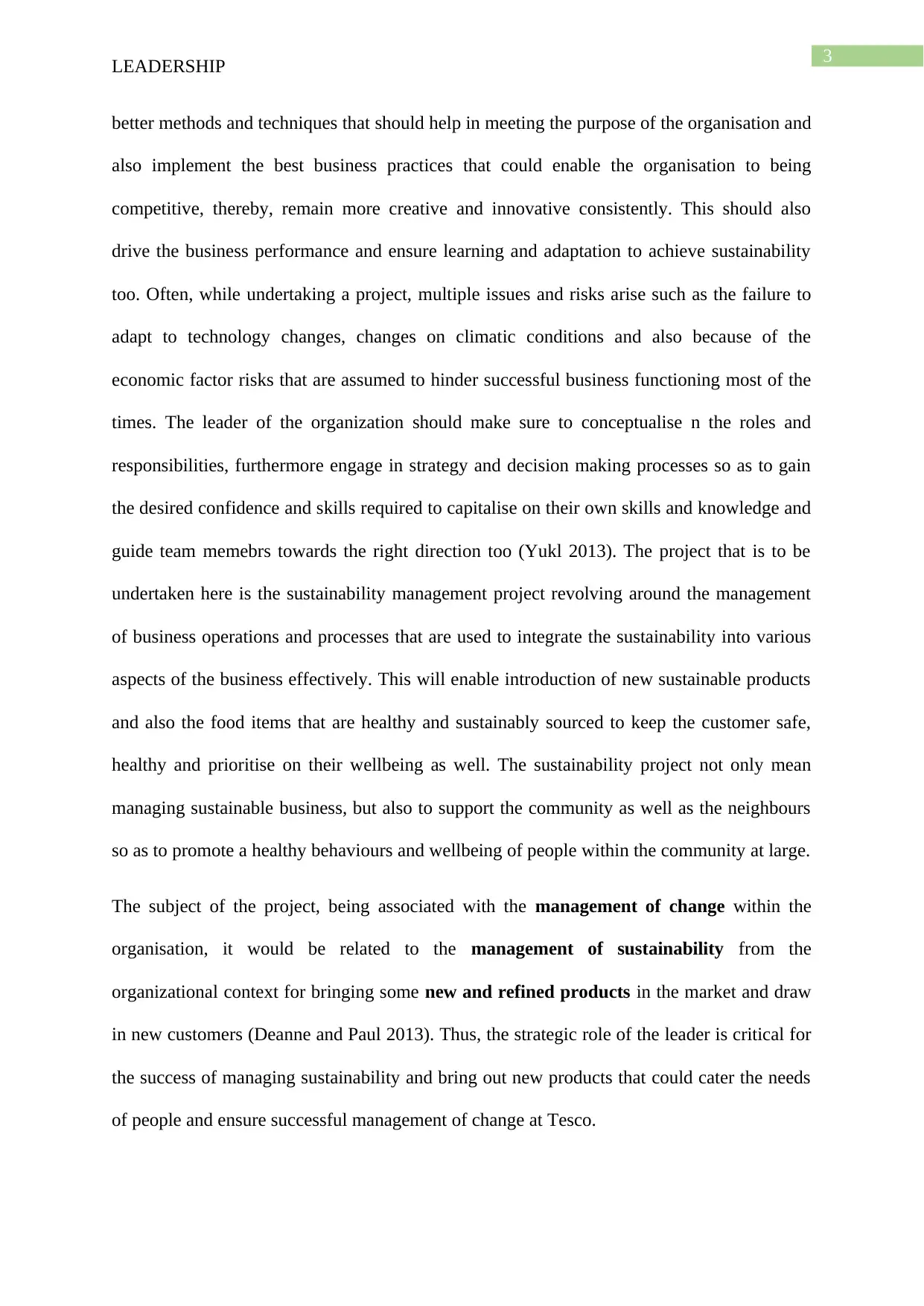
3
LEADERSHIP
better methods and techniques that should help in meeting the purpose of the organisation and
also implement the best business practices that could enable the organisation to being
competitive, thereby, remain more creative and innovative consistently. This should also
drive the business performance and ensure learning and adaptation to achieve sustainability
too. Often, while undertaking a project, multiple issues and risks arise such as the failure to
adapt to technology changes, changes on climatic conditions and also because of the
economic factor risks that are assumed to hinder successful business functioning most of the
times. The leader of the organization should make sure to conceptualise n the roles and
responsibilities, furthermore engage in strategy and decision making processes so as to gain
the desired confidence and skills required to capitalise on their own skills and knowledge and
guide team memebrs towards the right direction too (Yukl 2013). The project that is to be
undertaken here is the sustainability management project revolving around the management
of business operations and processes that are used to integrate the sustainability into various
aspects of the business effectively. This will enable introduction of new sustainable products
and also the food items that are healthy and sustainably sourced to keep the customer safe,
healthy and prioritise on their wellbeing as well. The sustainability project not only mean
managing sustainable business, but also to support the community as well as the neighbours
so as to promote a healthy behaviours and wellbeing of people within the community at large.
The subject of the project, being associated with the management of change within the
organisation, it would be related to the management of sustainability from the
organizational context for bringing some new and refined products in the market and draw
in new customers (Deanne and Paul 2013). Thus, the strategic role of the leader is critical for
the success of managing sustainability and bring out new products that could cater the needs
of people and ensure successful management of change at Tesco.
LEADERSHIP
better methods and techniques that should help in meeting the purpose of the organisation and
also implement the best business practices that could enable the organisation to being
competitive, thereby, remain more creative and innovative consistently. This should also
drive the business performance and ensure learning and adaptation to achieve sustainability
too. Often, while undertaking a project, multiple issues and risks arise such as the failure to
adapt to technology changes, changes on climatic conditions and also because of the
economic factor risks that are assumed to hinder successful business functioning most of the
times. The leader of the organization should make sure to conceptualise n the roles and
responsibilities, furthermore engage in strategy and decision making processes so as to gain
the desired confidence and skills required to capitalise on their own skills and knowledge and
guide team memebrs towards the right direction too (Yukl 2013). The project that is to be
undertaken here is the sustainability management project revolving around the management
of business operations and processes that are used to integrate the sustainability into various
aspects of the business effectively. This will enable introduction of new sustainable products
and also the food items that are healthy and sustainably sourced to keep the customer safe,
healthy and prioritise on their wellbeing as well. The sustainability project not only mean
managing sustainable business, but also to support the community as well as the neighbours
so as to promote a healthy behaviours and wellbeing of people within the community at large.
The subject of the project, being associated with the management of change within the
organisation, it would be related to the management of sustainability from the
organizational context for bringing some new and refined products in the market and draw
in new customers (Deanne and Paul 2013). Thus, the strategic role of the leader is critical for
the success of managing sustainability and bring out new products that could cater the needs
of people and ensure successful management of change at Tesco.
Paraphrase This Document
Need a fresh take? Get an instant paraphrase of this document with our AI Paraphraser
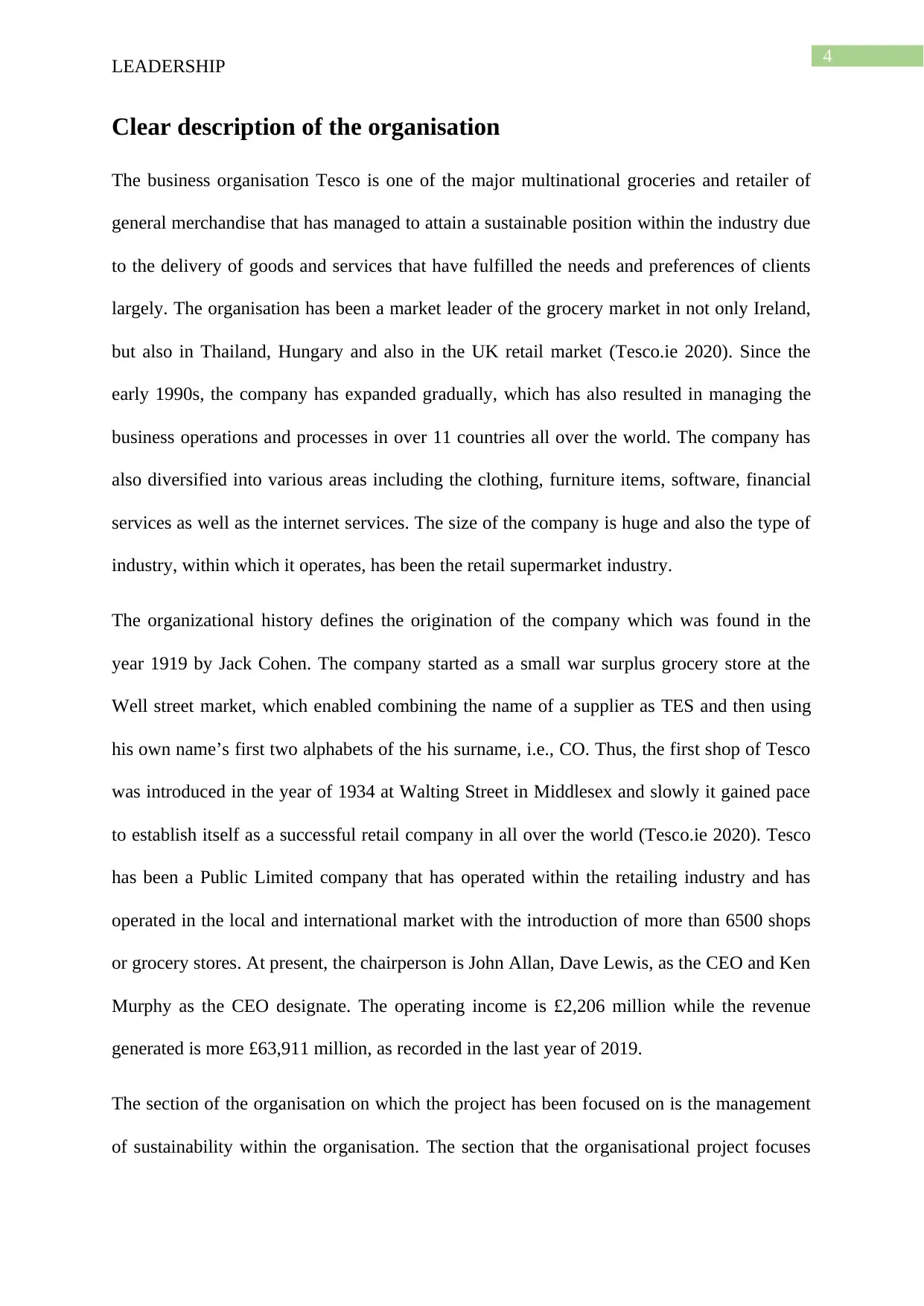
4
LEADERSHIP
Clear description of the organisation
The business organisation Tesco is one of the major multinational groceries and retailer of
general merchandise that has managed to attain a sustainable position within the industry due
to the delivery of goods and services that have fulfilled the needs and preferences of clients
largely. The organisation has been a market leader of the grocery market in not only Ireland,
but also in Thailand, Hungary and also in the UK retail market (Tesco.ie 2020). Since the
early 1990s, the company has expanded gradually, which has also resulted in managing the
business operations and processes in over 11 countries all over the world. The company has
also diversified into various areas including the clothing, furniture items, software, financial
services as well as the internet services. The size of the company is huge and also the type of
industry, within which it operates, has been the retail supermarket industry.
The organizational history defines the origination of the company which was found in the
year 1919 by Jack Cohen. The company started as a small war surplus grocery store at the
Well street market, which enabled combining the name of a supplier as TES and then using
his own name’s first two alphabets of the his surname, i.e., CO. Thus, the first shop of Tesco
was introduced in the year of 1934 at Walting Street in Middlesex and slowly it gained pace
to establish itself as a successful retail company in all over the world (Tesco.ie 2020). Tesco
has been a Public Limited company that has operated within the retailing industry and has
operated in the local and international market with the introduction of more than 6500 shops
or grocery stores. At present, the chairperson is John Allan, Dave Lewis, as the CEO and Ken
Murphy as the CEO designate. The operating income is £2,206 million while the revenue
generated is more £63,911 million, as recorded in the last year of 2019.
The section of the organisation on which the project has been focused on is the management
of sustainability within the organisation. The section that the organisational project focuses
LEADERSHIP
Clear description of the organisation
The business organisation Tesco is one of the major multinational groceries and retailer of
general merchandise that has managed to attain a sustainable position within the industry due
to the delivery of goods and services that have fulfilled the needs and preferences of clients
largely. The organisation has been a market leader of the grocery market in not only Ireland,
but also in Thailand, Hungary and also in the UK retail market (Tesco.ie 2020). Since the
early 1990s, the company has expanded gradually, which has also resulted in managing the
business operations and processes in over 11 countries all over the world. The company has
also diversified into various areas including the clothing, furniture items, software, financial
services as well as the internet services. The size of the company is huge and also the type of
industry, within which it operates, has been the retail supermarket industry.
The organizational history defines the origination of the company which was found in the
year 1919 by Jack Cohen. The company started as a small war surplus grocery store at the
Well street market, which enabled combining the name of a supplier as TES and then using
his own name’s first two alphabets of the his surname, i.e., CO. Thus, the first shop of Tesco
was introduced in the year of 1934 at Walting Street in Middlesex and slowly it gained pace
to establish itself as a successful retail company in all over the world (Tesco.ie 2020). Tesco
has been a Public Limited company that has operated within the retailing industry and has
operated in the local and international market with the introduction of more than 6500 shops
or grocery stores. At present, the chairperson is John Allan, Dave Lewis, as the CEO and Ken
Murphy as the CEO designate. The operating income is £2,206 million while the revenue
generated is more £63,911 million, as recorded in the last year of 2019.
The section of the organisation on which the project has been focused on is the management
of sustainability within the organisation. The section that the organisational project focuses
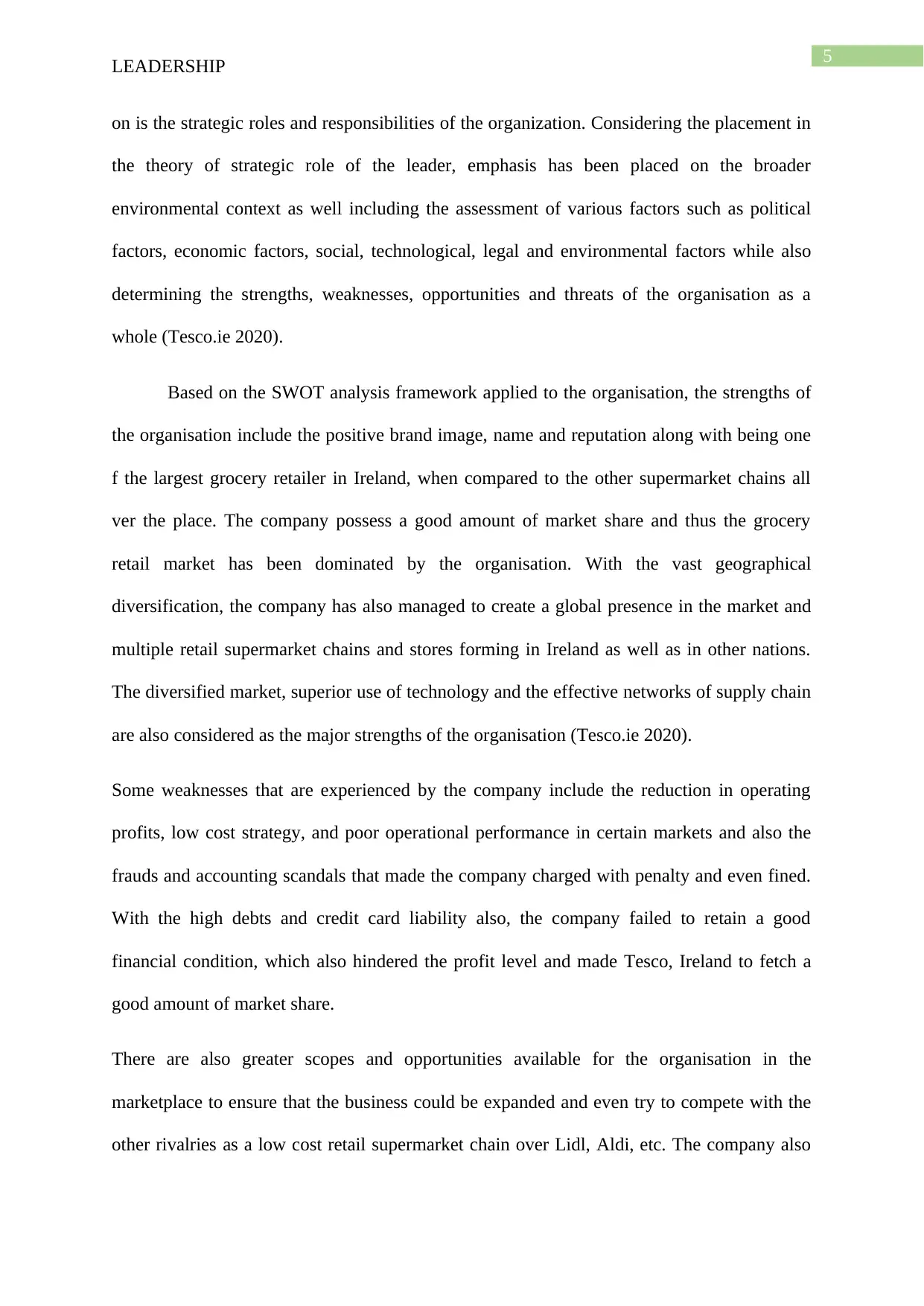
5
LEADERSHIP
on is the strategic roles and responsibilities of the organization. Considering the placement in
the theory of strategic role of the leader, emphasis has been placed on the broader
environmental context as well including the assessment of various factors such as political
factors, economic factors, social, technological, legal and environmental factors while also
determining the strengths, weaknesses, opportunities and threats of the organisation as a
whole (Tesco.ie 2020).
Based on the SWOT analysis framework applied to the organisation, the strengths of
the organisation include the positive brand image, name and reputation along with being one
f the largest grocery retailer in Ireland, when compared to the other supermarket chains all
ver the place. The company possess a good amount of market share and thus the grocery
retail market has been dominated by the organisation. With the vast geographical
diversification, the company has also managed to create a global presence in the market and
multiple retail supermarket chains and stores forming in Ireland as well as in other nations.
The diversified market, superior use of technology and the effective networks of supply chain
are also considered as the major strengths of the organisation (Tesco.ie 2020).
Some weaknesses that are experienced by the company include the reduction in operating
profits, low cost strategy, and poor operational performance in certain markets and also the
frauds and accounting scandals that made the company charged with penalty and even fined.
With the high debts and credit card liability also, the company failed to retain a good
financial condition, which also hindered the profit level and made Tesco, Ireland to fetch a
good amount of market share.
There are also greater scopes and opportunities available for the organisation in the
marketplace to ensure that the business could be expanded and even try to compete with the
other rivalries as a low cost retail supermarket chain over Lidl, Aldi, etc. The company also
LEADERSHIP
on is the strategic roles and responsibilities of the organization. Considering the placement in
the theory of strategic role of the leader, emphasis has been placed on the broader
environmental context as well including the assessment of various factors such as political
factors, economic factors, social, technological, legal and environmental factors while also
determining the strengths, weaknesses, opportunities and threats of the organisation as a
whole (Tesco.ie 2020).
Based on the SWOT analysis framework applied to the organisation, the strengths of
the organisation include the positive brand image, name and reputation along with being one
f the largest grocery retailer in Ireland, when compared to the other supermarket chains all
ver the place. The company possess a good amount of market share and thus the grocery
retail market has been dominated by the organisation. With the vast geographical
diversification, the company has also managed to create a global presence in the market and
multiple retail supermarket chains and stores forming in Ireland as well as in other nations.
The diversified market, superior use of technology and the effective networks of supply chain
are also considered as the major strengths of the organisation (Tesco.ie 2020).
Some weaknesses that are experienced by the company include the reduction in operating
profits, low cost strategy, and poor operational performance in certain markets and also the
frauds and accounting scandals that made the company charged with penalty and even fined.
With the high debts and credit card liability also, the company failed to retain a good
financial condition, which also hindered the profit level and made Tesco, Ireland to fetch a
good amount of market share.
There are also greater scopes and opportunities available for the organisation in the
marketplace to ensure that the business could be expanded and even try to compete with the
other rivalries as a low cost retail supermarket chain over Lidl, Aldi, etc. The company also
⊘ This is a preview!⊘
Do you want full access?
Subscribe today to unlock all pages.

Trusted by 1+ million students worldwide
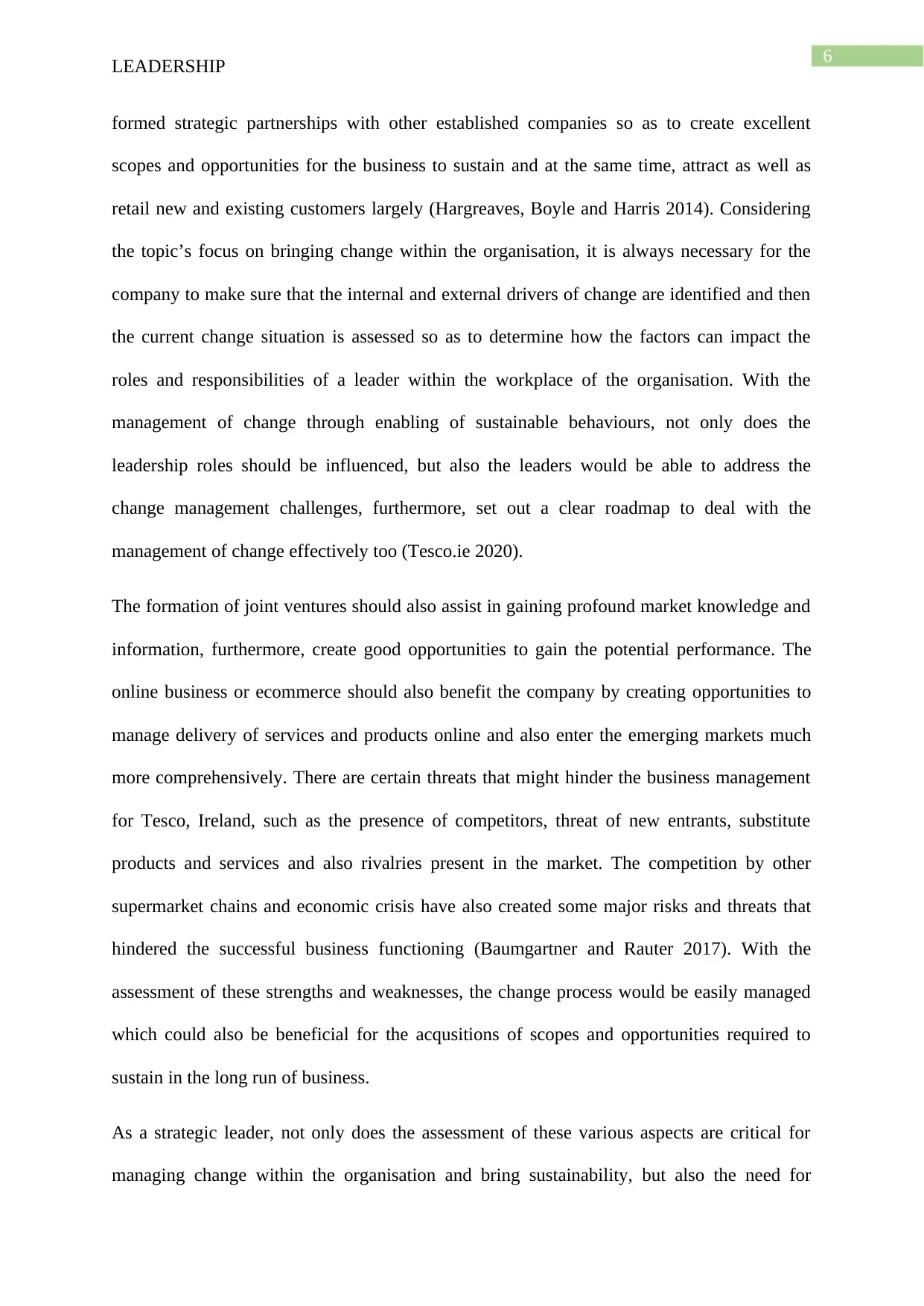
6
LEADERSHIP
formed strategic partnerships with other established companies so as to create excellent
scopes and opportunities for the business to sustain and at the same time, attract as well as
retail new and existing customers largely (Hargreaves, Boyle and Harris 2014). Considering
the topic’s focus on bringing change within the organisation, it is always necessary for the
company to make sure that the internal and external drivers of change are identified and then
the current change situation is assessed so as to determine how the factors can impact the
roles and responsibilities of a leader within the workplace of the organisation. With the
management of change through enabling of sustainable behaviours, not only does the
leadership roles should be influenced, but also the leaders would be able to address the
change management challenges, furthermore, set out a clear roadmap to deal with the
management of change effectively too (Tesco.ie 2020).
The formation of joint ventures should also assist in gaining profound market knowledge and
information, furthermore, create good opportunities to gain the potential performance. The
online business or ecommerce should also benefit the company by creating opportunities to
manage delivery of services and products online and also enter the emerging markets much
more comprehensively. There are certain threats that might hinder the business management
for Tesco, Ireland, such as the presence of competitors, threat of new entrants, substitute
products and services and also rivalries present in the market. The competition by other
supermarket chains and economic crisis have also created some major risks and threats that
hindered the successful business functioning (Baumgartner and Rauter 2017). With the
assessment of these strengths and weaknesses, the change process would be easily managed
which could also be beneficial for the acqusitions of scopes and opportunities required to
sustain in the long run of business.
As a strategic leader, not only does the assessment of these various aspects are critical for
managing change within the organisation and bring sustainability, but also the need for
LEADERSHIP
formed strategic partnerships with other established companies so as to create excellent
scopes and opportunities for the business to sustain and at the same time, attract as well as
retail new and existing customers largely (Hargreaves, Boyle and Harris 2014). Considering
the topic’s focus on bringing change within the organisation, it is always necessary for the
company to make sure that the internal and external drivers of change are identified and then
the current change situation is assessed so as to determine how the factors can impact the
roles and responsibilities of a leader within the workplace of the organisation. With the
management of change through enabling of sustainable behaviours, not only does the
leadership roles should be influenced, but also the leaders would be able to address the
change management challenges, furthermore, set out a clear roadmap to deal with the
management of change effectively too (Tesco.ie 2020).
The formation of joint ventures should also assist in gaining profound market knowledge and
information, furthermore, create good opportunities to gain the potential performance. The
online business or ecommerce should also benefit the company by creating opportunities to
manage delivery of services and products online and also enter the emerging markets much
more comprehensively. There are certain threats that might hinder the business management
for Tesco, Ireland, such as the presence of competitors, threat of new entrants, substitute
products and services and also rivalries present in the market. The competition by other
supermarket chains and economic crisis have also created some major risks and threats that
hindered the successful business functioning (Baumgartner and Rauter 2017). With the
assessment of these strengths and weaknesses, the change process would be easily managed
which could also be beneficial for the acqusitions of scopes and opportunities required to
sustain in the long run of business.
As a strategic leader, not only does the assessment of these various aspects are critical for
managing change within the organisation and bring sustainability, but also the need for
Paraphrase This Document
Need a fresh take? Get an instant paraphrase of this document with our AI Paraphraser
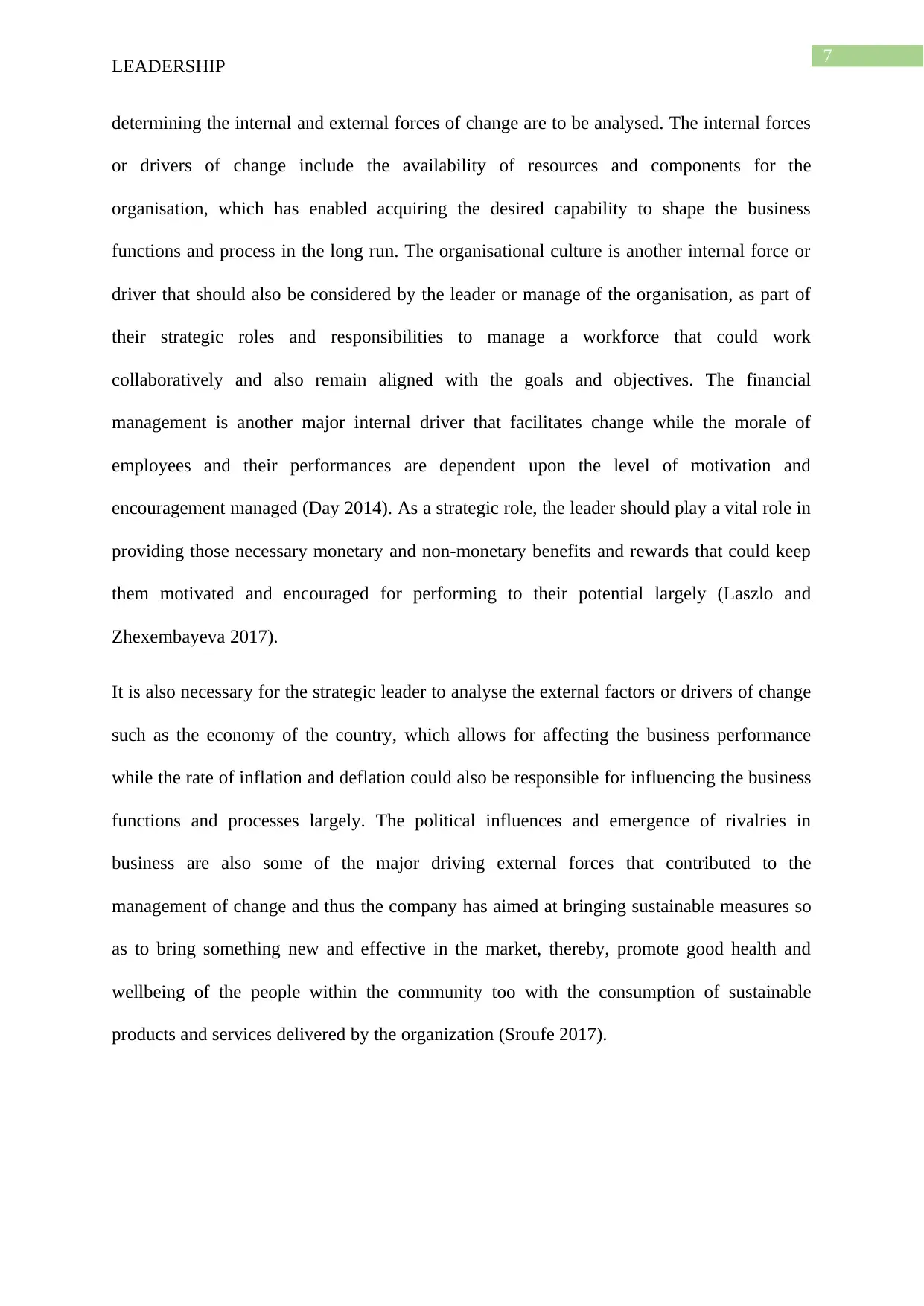
7
LEADERSHIP
determining the internal and external forces of change are to be analysed. The internal forces
or drivers of change include the availability of resources and components for the
organisation, which has enabled acquiring the desired capability to shape the business
functions and process in the long run. The organisational culture is another internal force or
driver that should also be considered by the leader or manage of the organisation, as part of
their strategic roles and responsibilities to manage a workforce that could work
collaboratively and also remain aligned with the goals and objectives. The financial
management is another major internal driver that facilitates change while the morale of
employees and their performances are dependent upon the level of motivation and
encouragement managed (Day 2014). As a strategic role, the leader should play a vital role in
providing those necessary monetary and non-monetary benefits and rewards that could keep
them motivated and encouraged for performing to their potential largely (Laszlo and
Zhexembayeva 2017).
It is also necessary for the strategic leader to analyse the external factors or drivers of change
such as the economy of the country, which allows for affecting the business performance
while the rate of inflation and deflation could also be responsible for influencing the business
functions and processes largely. The political influences and emergence of rivalries in
business are also some of the major driving external forces that contributed to the
management of change and thus the company has aimed at bringing sustainable measures so
as to bring something new and effective in the market, thereby, promote good health and
wellbeing of the people within the community too with the consumption of sustainable
products and services delivered by the organization (Sroufe 2017).
LEADERSHIP
determining the internal and external forces of change are to be analysed. The internal forces
or drivers of change include the availability of resources and components for the
organisation, which has enabled acquiring the desired capability to shape the business
functions and process in the long run. The organisational culture is another internal force or
driver that should also be considered by the leader or manage of the organisation, as part of
their strategic roles and responsibilities to manage a workforce that could work
collaboratively and also remain aligned with the goals and objectives. The financial
management is another major internal driver that facilitates change while the morale of
employees and their performances are dependent upon the level of motivation and
encouragement managed (Day 2014). As a strategic role, the leader should play a vital role in
providing those necessary monetary and non-monetary benefits and rewards that could keep
them motivated and encouraged for performing to their potential largely (Laszlo and
Zhexembayeva 2017).
It is also necessary for the strategic leader to analyse the external factors or drivers of change
such as the economy of the country, which allows for affecting the business performance
while the rate of inflation and deflation could also be responsible for influencing the business
functions and processes largely. The political influences and emergence of rivalries in
business are also some of the major driving external forces that contributed to the
management of change and thus the company has aimed at bringing sustainable measures so
as to bring something new and effective in the market, thereby, promote good health and
wellbeing of the people within the community too with the consumption of sustainable
products and services delivered by the organization (Sroufe 2017).
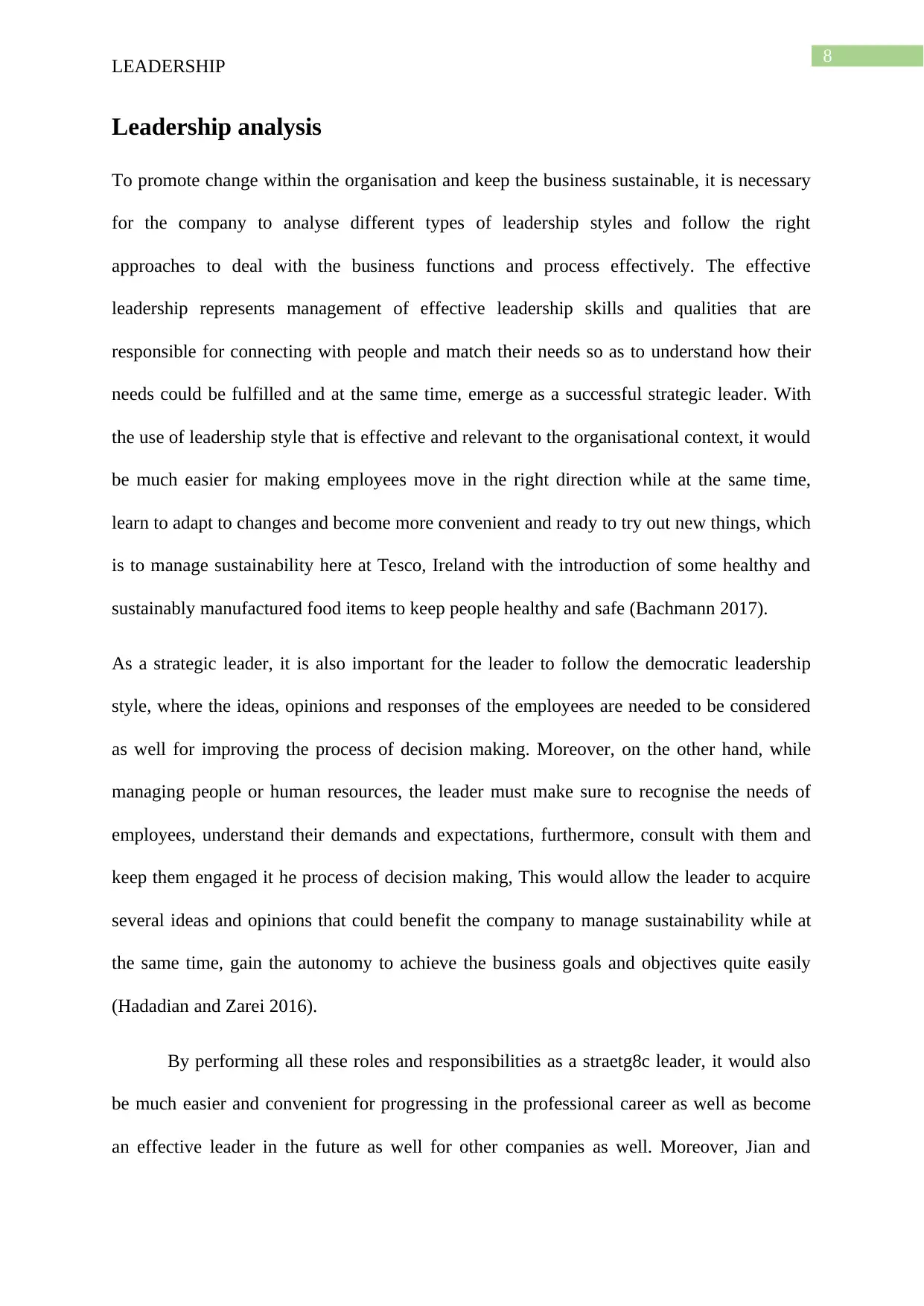
8
LEADERSHIP
Leadership analysis
To promote change within the organisation and keep the business sustainable, it is necessary
for the company to analyse different types of leadership styles and follow the right
approaches to deal with the business functions and process effectively. The effective
leadership represents management of effective leadership skills and qualities that are
responsible for connecting with people and match their needs so as to understand how their
needs could be fulfilled and at the same time, emerge as a successful strategic leader. With
the use of leadership style that is effective and relevant to the organisational context, it would
be much easier for making employees move in the right direction while at the same time,
learn to adapt to changes and become more convenient and ready to try out new things, which
is to manage sustainability here at Tesco, Ireland with the introduction of some healthy and
sustainably manufactured food items to keep people healthy and safe (Bachmann 2017).
As a strategic leader, it is also important for the leader to follow the democratic leadership
style, where the ideas, opinions and responses of the employees are needed to be considered
as well for improving the process of decision making. Moreover, on the other hand, while
managing people or human resources, the leader must make sure to recognise the needs of
employees, understand their demands and expectations, furthermore, consult with them and
keep them engaged it he process of decision making, This would allow the leader to acquire
several ideas and opinions that could benefit the company to manage sustainability while at
the same time, gain the autonomy to achieve the business goals and objectives quite easily
(Hadadian and Zarei 2016).
By performing all these roles and responsibilities as a straetg8c leader, it would also
be much easier and convenient for progressing in the professional career as well as become
an effective leader in the future as well for other companies as well. Moreover, Jian and
LEADERSHIP
Leadership analysis
To promote change within the organisation and keep the business sustainable, it is necessary
for the company to analyse different types of leadership styles and follow the right
approaches to deal with the business functions and process effectively. The effective
leadership represents management of effective leadership skills and qualities that are
responsible for connecting with people and match their needs so as to understand how their
needs could be fulfilled and at the same time, emerge as a successful strategic leader. With
the use of leadership style that is effective and relevant to the organisational context, it would
be much easier for making employees move in the right direction while at the same time,
learn to adapt to changes and become more convenient and ready to try out new things, which
is to manage sustainability here at Tesco, Ireland with the introduction of some healthy and
sustainably manufactured food items to keep people healthy and safe (Bachmann 2017).
As a strategic leader, it is also important for the leader to follow the democratic leadership
style, where the ideas, opinions and responses of the employees are needed to be considered
as well for improving the process of decision making. Moreover, on the other hand, while
managing people or human resources, the leader must make sure to recognise the needs of
employees, understand their demands and expectations, furthermore, consult with them and
keep them engaged it he process of decision making, This would allow the leader to acquire
several ideas and opinions that could benefit the company to manage sustainability while at
the same time, gain the autonomy to achieve the business goals and objectives quite easily
(Hadadian and Zarei 2016).
By performing all these roles and responsibilities as a straetg8c leader, it would also
be much easier and convenient for progressing in the professional career as well as become
an effective leader in the future as well for other companies as well. Moreover, Jian and
⊘ This is a preview!⊘
Do you want full access?
Subscribe today to unlock all pages.

Trusted by 1+ million students worldwide
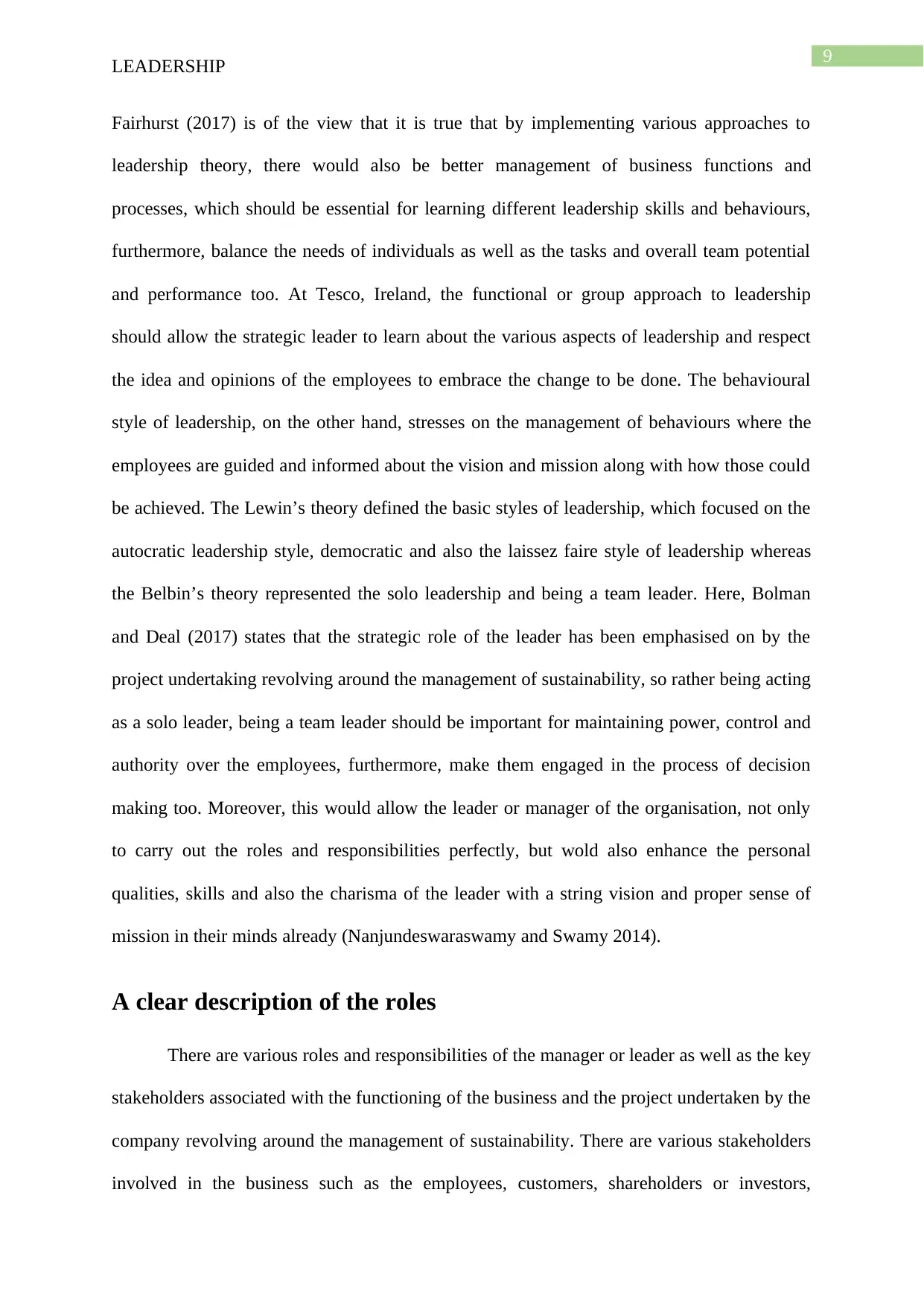
9
LEADERSHIP
Fairhurst (2017) is of the view that it is true that by implementing various approaches to
leadership theory, there would also be better management of business functions and
processes, which should be essential for learning different leadership skills and behaviours,
furthermore, balance the needs of individuals as well as the tasks and overall team potential
and performance too. At Tesco, Ireland, the functional or group approach to leadership
should allow the strategic leader to learn about the various aspects of leadership and respect
the idea and opinions of the employees to embrace the change to be done. The behavioural
style of leadership, on the other hand, stresses on the management of behaviours where the
employees are guided and informed about the vision and mission along with how those could
be achieved. The Lewin’s theory defined the basic styles of leadership, which focused on the
autocratic leadership style, democratic and also the laissez faire style of leadership whereas
the Belbin’s theory represented the solo leadership and being a team leader. Here, Bolman
and Deal (2017) states that the strategic role of the leader has been emphasised on by the
project undertaking revolving around the management of sustainability, so rather being acting
as a solo leader, being a team leader should be important for maintaining power, control and
authority over the employees, furthermore, make them engaged in the process of decision
making too. Moreover, this would allow the leader or manager of the organisation, not only
to carry out the roles and responsibilities perfectly, but wold also enhance the personal
qualities, skills and also the charisma of the leader with a string vision and proper sense of
mission in their minds already (Nanjundeswaraswamy and Swamy 2014).
A clear description of the roles
There are various roles and responsibilities of the manager or leader as well as the key
stakeholders associated with the functioning of the business and the project undertaken by the
company revolving around the management of sustainability. There are various stakeholders
involved in the business such as the employees, customers, shareholders or investors,
LEADERSHIP
Fairhurst (2017) is of the view that it is true that by implementing various approaches to
leadership theory, there would also be better management of business functions and
processes, which should be essential for learning different leadership skills and behaviours,
furthermore, balance the needs of individuals as well as the tasks and overall team potential
and performance too. At Tesco, Ireland, the functional or group approach to leadership
should allow the strategic leader to learn about the various aspects of leadership and respect
the idea and opinions of the employees to embrace the change to be done. The behavioural
style of leadership, on the other hand, stresses on the management of behaviours where the
employees are guided and informed about the vision and mission along with how those could
be achieved. The Lewin’s theory defined the basic styles of leadership, which focused on the
autocratic leadership style, democratic and also the laissez faire style of leadership whereas
the Belbin’s theory represented the solo leadership and being a team leader. Here, Bolman
and Deal (2017) states that the strategic role of the leader has been emphasised on by the
project undertaking revolving around the management of sustainability, so rather being acting
as a solo leader, being a team leader should be important for maintaining power, control and
authority over the employees, furthermore, make them engaged in the process of decision
making too. Moreover, this would allow the leader or manager of the organisation, not only
to carry out the roles and responsibilities perfectly, but wold also enhance the personal
qualities, skills and also the charisma of the leader with a string vision and proper sense of
mission in their minds already (Nanjundeswaraswamy and Swamy 2014).
A clear description of the roles
There are various roles and responsibilities of the manager or leader as well as the key
stakeholders associated with the functioning of the business and the project undertaken by the
company revolving around the management of sustainability. There are various stakeholders
involved in the business such as the employees, customers, shareholders or investors,
Paraphrase This Document
Need a fresh take? Get an instant paraphrase of this document with our AI Paraphraser
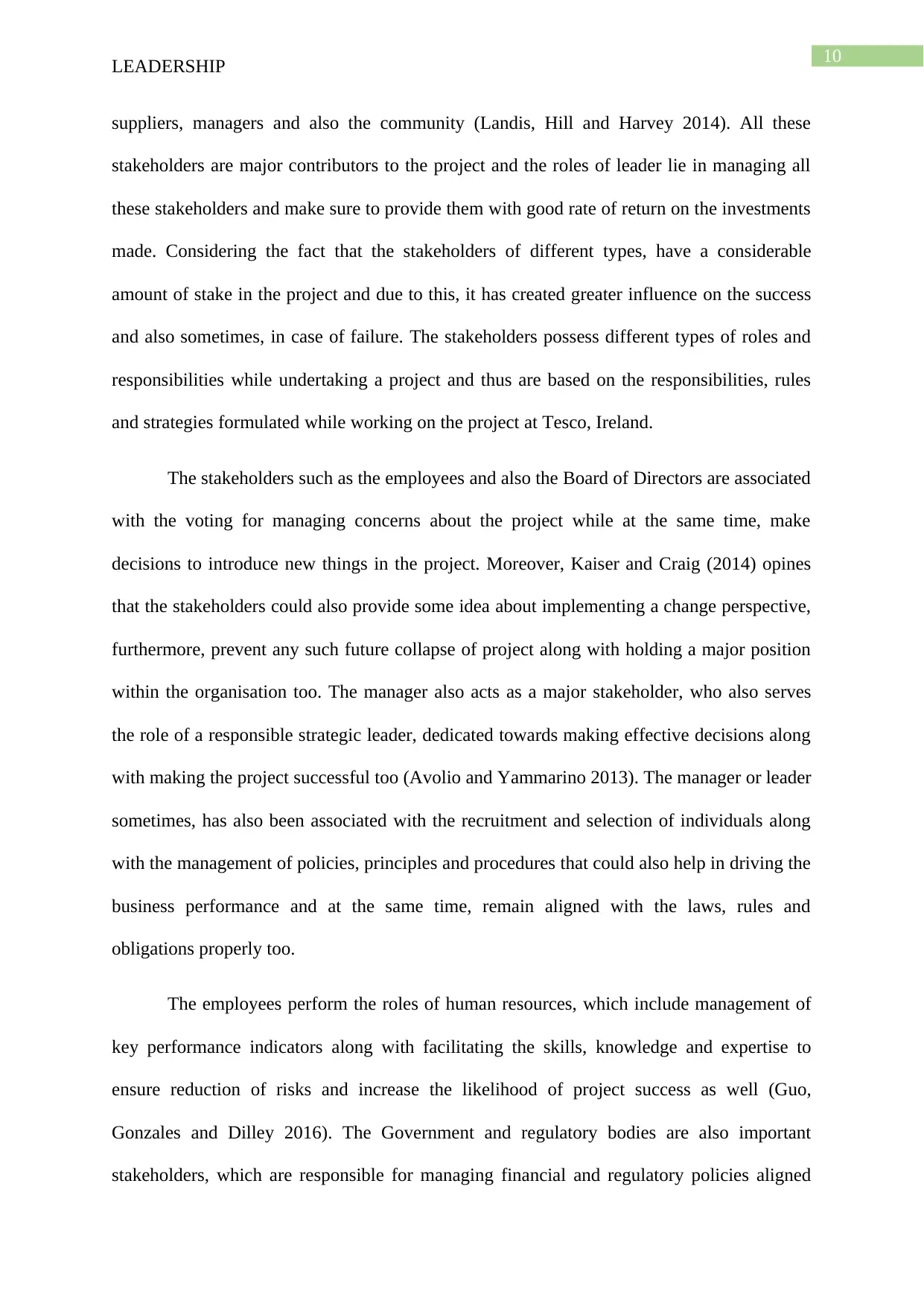
10
LEADERSHIP
suppliers, managers and also the community (Landis, Hill and Harvey 2014). All these
stakeholders are major contributors to the project and the roles of leader lie in managing all
these stakeholders and make sure to provide them with good rate of return on the investments
made. Considering the fact that the stakeholders of different types, have a considerable
amount of stake in the project and due to this, it has created greater influence on the success
and also sometimes, in case of failure. The stakeholders possess different types of roles and
responsibilities while undertaking a project and thus are based on the responsibilities, rules
and strategies formulated while working on the project at Tesco, Ireland.
The stakeholders such as the employees and also the Board of Directors are associated
with the voting for managing concerns about the project while at the same time, make
decisions to introduce new things in the project. Moreover, Kaiser and Craig (2014) opines
that the stakeholders could also provide some idea about implementing a change perspective,
furthermore, prevent any such future collapse of project along with holding a major position
within the organisation too. The manager also acts as a major stakeholder, who also serves
the role of a responsible strategic leader, dedicated towards making effective decisions along
with making the project successful too (Avolio and Yammarino 2013). The manager or leader
sometimes, has also been associated with the recruitment and selection of individuals along
with the management of policies, principles and procedures that could also help in driving the
business performance and at the same time, remain aligned with the laws, rules and
obligations properly too.
The employees perform the roles of human resources, which include management of
key performance indicators along with facilitating the skills, knowledge and expertise to
ensure reduction of risks and increase the likelihood of project success as well (Guo,
Gonzales and Dilley 2016). The Government and regulatory bodies are also important
stakeholders, which are responsible for managing financial and regulatory policies aligned
LEADERSHIP
suppliers, managers and also the community (Landis, Hill and Harvey 2014). All these
stakeholders are major contributors to the project and the roles of leader lie in managing all
these stakeholders and make sure to provide them with good rate of return on the investments
made. Considering the fact that the stakeholders of different types, have a considerable
amount of stake in the project and due to this, it has created greater influence on the success
and also sometimes, in case of failure. The stakeholders possess different types of roles and
responsibilities while undertaking a project and thus are based on the responsibilities, rules
and strategies formulated while working on the project at Tesco, Ireland.
The stakeholders such as the employees and also the Board of Directors are associated
with the voting for managing concerns about the project while at the same time, make
decisions to introduce new things in the project. Moreover, Kaiser and Craig (2014) opines
that the stakeholders could also provide some idea about implementing a change perspective,
furthermore, prevent any such future collapse of project along with holding a major position
within the organisation too. The manager also acts as a major stakeholder, who also serves
the role of a responsible strategic leader, dedicated towards making effective decisions along
with making the project successful too (Avolio and Yammarino 2013). The manager or leader
sometimes, has also been associated with the recruitment and selection of individuals along
with the management of policies, principles and procedures that could also help in driving the
business performance and at the same time, remain aligned with the laws, rules and
obligations properly too.
The employees perform the roles of human resources, which include management of
key performance indicators along with facilitating the skills, knowledge and expertise to
ensure reduction of risks and increase the likelihood of project success as well (Guo,
Gonzales and Dilley 2016). The Government and regulatory bodies are also important
stakeholders, which are responsible for managing financial and regulatory policies aligned
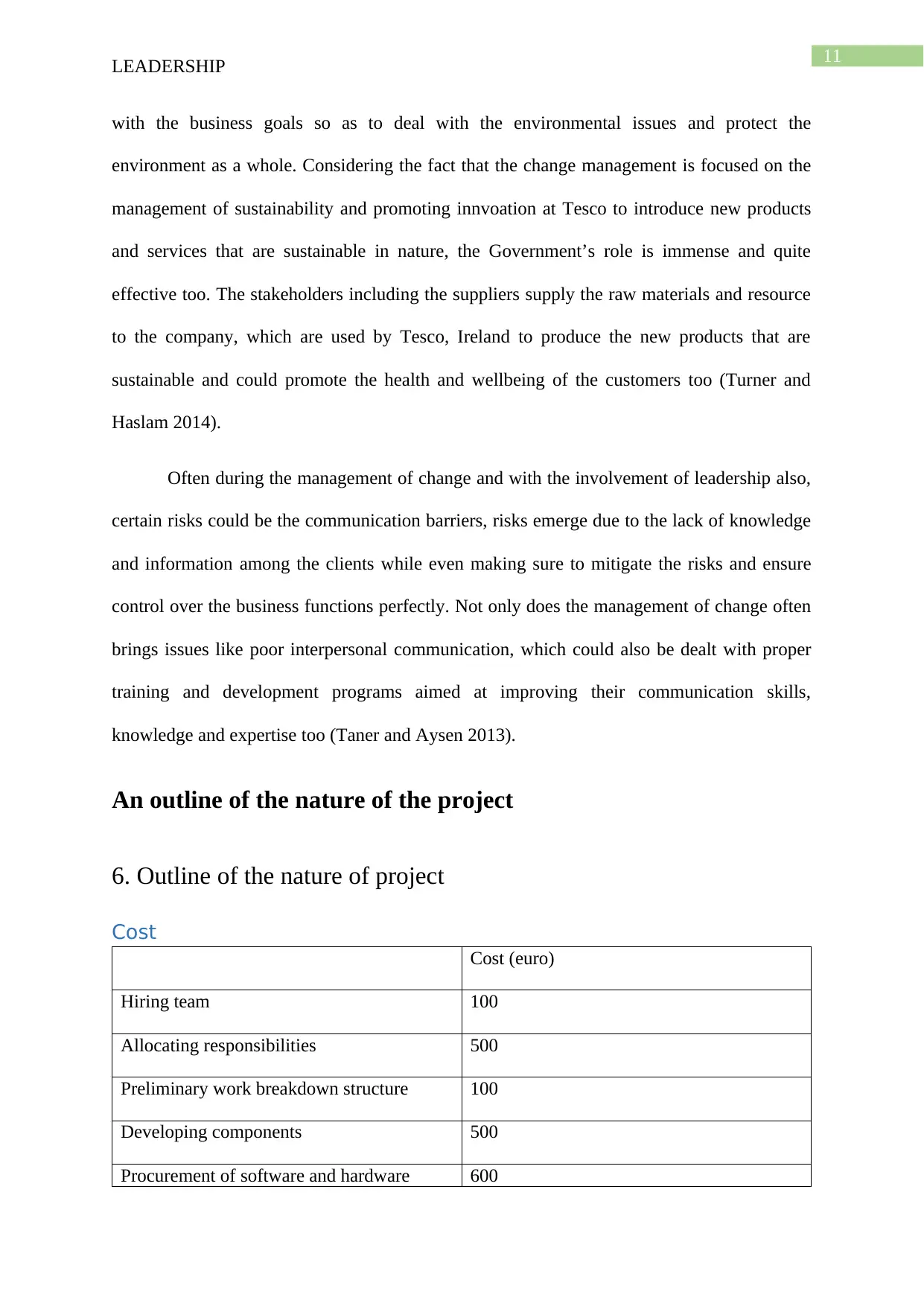
11
LEADERSHIP
with the business goals so as to deal with the environmental issues and protect the
environment as a whole. Considering the fact that the change management is focused on the
management of sustainability and promoting innvoation at Tesco to introduce new products
and services that are sustainable in nature, the Government’s role is immense and quite
effective too. The stakeholders including the suppliers supply the raw materials and resource
to the company, which are used by Tesco, Ireland to produce the new products that are
sustainable and could promote the health and wellbeing of the customers too (Turner and
Haslam 2014).
Often during the management of change and with the involvement of leadership also,
certain risks could be the communication barriers, risks emerge due to the lack of knowledge
and information among the clients while even making sure to mitigate the risks and ensure
control over the business functions perfectly. Not only does the management of change often
brings issues like poor interpersonal communication, which could also be dealt with proper
training and development programs aimed at improving their communication skills,
knowledge and expertise too (Taner and Aysen 2013).
An outline of the nature of the project
6. Outline of the nature of project
Cost
Cost (euro)
Hiring team 100
Allocating responsibilities 500
Preliminary work breakdown structure 100
Developing components 500
Procurement of software and hardware 600
LEADERSHIP
with the business goals so as to deal with the environmental issues and protect the
environment as a whole. Considering the fact that the change management is focused on the
management of sustainability and promoting innvoation at Tesco to introduce new products
and services that are sustainable in nature, the Government’s role is immense and quite
effective too. The stakeholders including the suppliers supply the raw materials and resource
to the company, which are used by Tesco, Ireland to produce the new products that are
sustainable and could promote the health and wellbeing of the customers too (Turner and
Haslam 2014).
Often during the management of change and with the involvement of leadership also,
certain risks could be the communication barriers, risks emerge due to the lack of knowledge
and information among the clients while even making sure to mitigate the risks and ensure
control over the business functions perfectly. Not only does the management of change often
brings issues like poor interpersonal communication, which could also be dealt with proper
training and development programs aimed at improving their communication skills,
knowledge and expertise too (Taner and Aysen 2013).
An outline of the nature of the project
6. Outline of the nature of project
Cost
Cost (euro)
Hiring team 100
Allocating responsibilities 500
Preliminary work breakdown structure 100
Developing components 500
Procurement of software and hardware 600
⊘ This is a preview!⊘
Do you want full access?
Subscribe today to unlock all pages.

Trusted by 1+ million students worldwide
1 out of 17
Related Documents
Your All-in-One AI-Powered Toolkit for Academic Success.
+13062052269
info@desklib.com
Available 24*7 on WhatsApp / Email
![[object Object]](/_next/static/media/star-bottom.7253800d.svg)
Unlock your academic potential
Copyright © 2020–2025 A2Z Services. All Rights Reserved. Developed and managed by ZUCOL.





